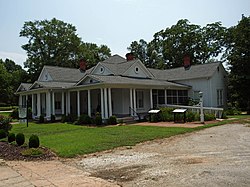Morgan House | |
 Morgan House, August 2010 | |
| Location | 416 Church St., Central, South Carolina |
|---|---|
| Coordinates | 34°43′20″N82°46′49″W / 34.72222°N 82.78028°W |
| Area | 2.8 acres (1.1 ha) |
| Built | 1893, c. 1917 |
| Architectural style | Queen Anne, Classical Revival |
| NRHP reference No. | 01000312 [1] |
| Added to NRHP | March 29, 2001 |
Morgan House is a historic home located Central, Pickens County, South Carolina. It was built in 1893 in the Queen Anne, and modified about 1917 with Classical Revival style changes. It is a 1+1⁄2-story frame dwelling and features a porch with Doric order columns. It is associated with the Morgan family, who operated a mercantile retail establishment and founders of the Bank of Central.
The house now serves as the home of the Central History Museum, which is operated by the Central Heritage Society. [2] [3]
It was listed on the National Register of Historic Places in 2001. [1]



